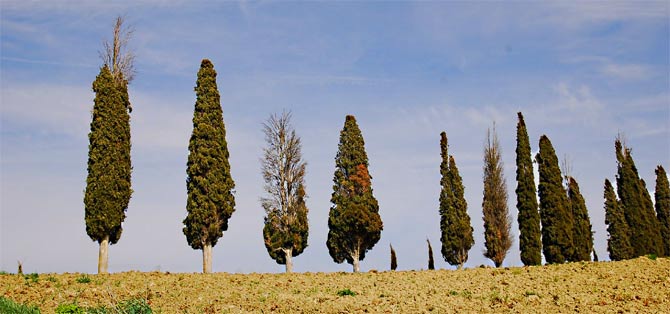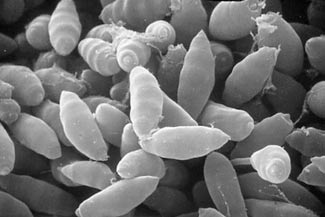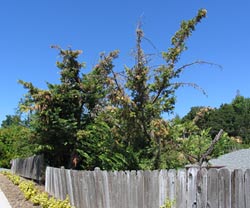 A row of Italian cypress trees near Siena, a city in Italy's Tuscany region. A number of trees show symptoms of cypress canker disease. Researchers have traced the origin of the pathogen responsible for the disease back to California. (Photo by Robert Danti, Italian National Research Council)
A row of Italian cypress trees near Siena, a city in Italy's Tuscany region. A number of trees show symptoms of cypress canker disease. Researchers have traced the origin of the pathogen responsible for the disease back to California. (Photo by Robert Danti, Italian National Research Council)
By Sarah Yang, UC Berkeley Media Relations
BERKELEY — A new study by UC Berkeley and Italian researchers spotlights the hazards of planting trees and other vegetation in regions where they are not native.

Solving a decades-long mystery, they have traced back to California the origins of a fungus that has killed cypress trees on six of the world’s seven continents. Their findings were published today (Thursday, Sept. 1) in the journal Phytopathology.
genetic detective work, the UC Berkeley and Italian National Research Council experts showed that the pathogen, Seiridium cardinale, that is responsible for cypress canker disease, has lived and thrived in California for a long time. It attacks trees in the cypress family by entering through cracks in their bark and producing toxins that wreak havoc with the flow of sap, choking off the supply of water and nutrients.
“The fungus was likely introduced from California either in the South of France or in Central Italy 60 to 80 years ago, and that introduction resulted in a global pandemic that has devastated the region’s iconic Italian cypress trees,” said Matteo Garbelotto, adjunct associate professor and cooperative extension specialist in ecosystem sciences at UC Berkeley.

The study authors advocate the genetic screening of plant shipments to stem the spread of the disease. Home gardeners who tend to pick the easiest plants to grow, added Garbelloto, should be careful about what they choose for their backyards, striving to use native plants that have grown naturally in a certain area for centuries.
“Monterey cypress became very popular in Europe because they grow faster, and they grow really well along the shore,” but that popularity, he said, may have inadvertently led to the spread of a deadly fungus through the world.
Tips for gardeners
What tree is best for your backyard? Garbelotto recommends:
- Go local. Consider a tree or plant’s native range, and ask if it was cultivated locally. Monterey cypress and coast redwoods, for example, should be planted in coastal areas, not inland.
- Avoid Leyland cypress, an ornamental hybrid that is extremely susceptible to S. cardinale. Most reputable nurseries no longer sell this variety, as it spreads the disease.
- Once a cypress tree gets this disease, don’t plant others nearby.
- If you’re inland and want to plant cypress trees, consider varieties of Arizona smooth bark cypress (Cupressus glabra) that are native to California. They are far more resistant to cypress canker disease.
